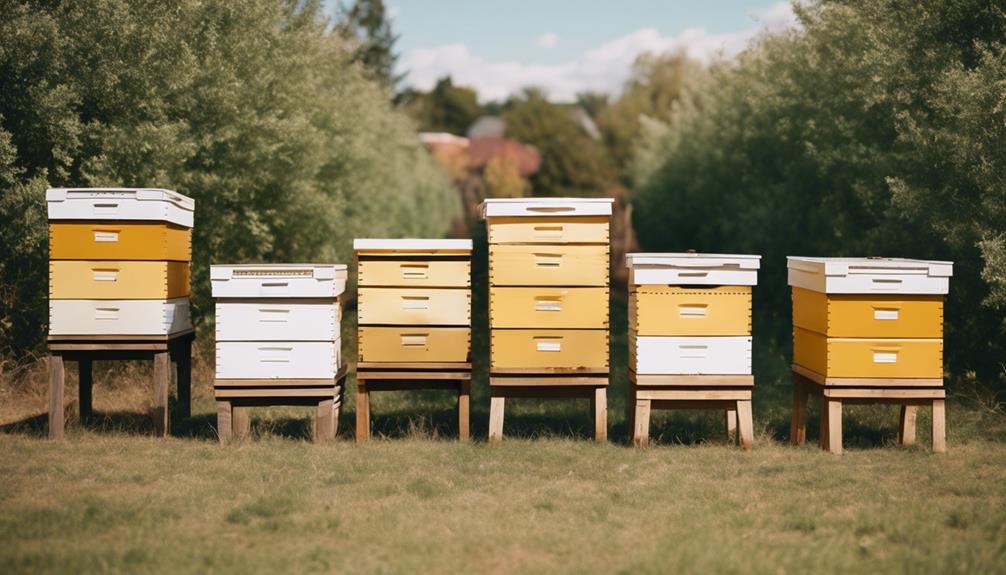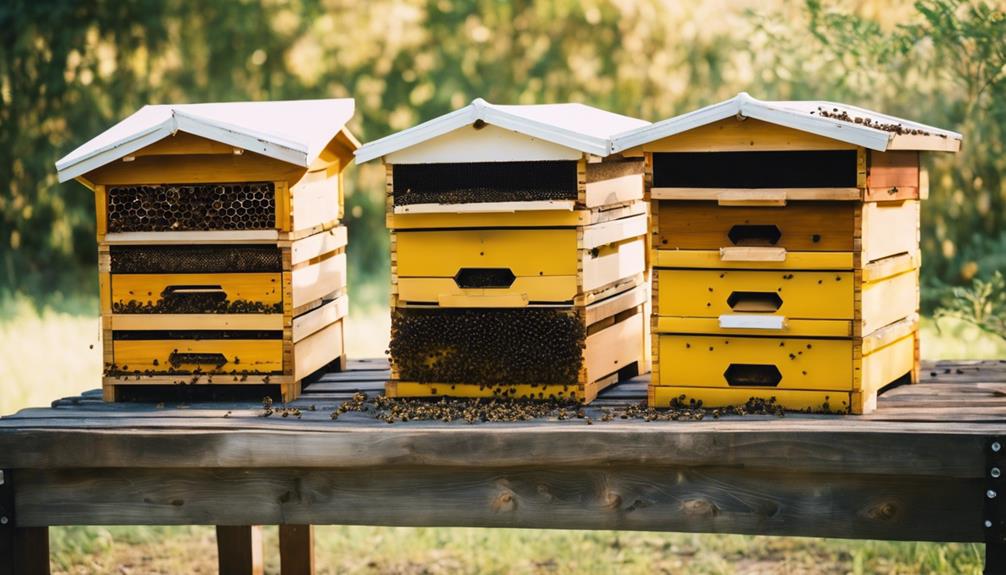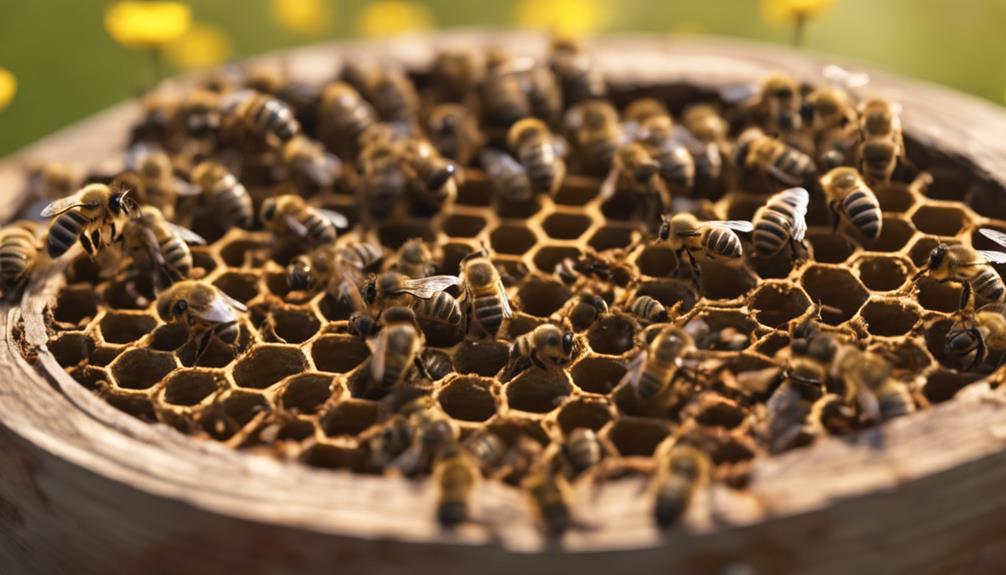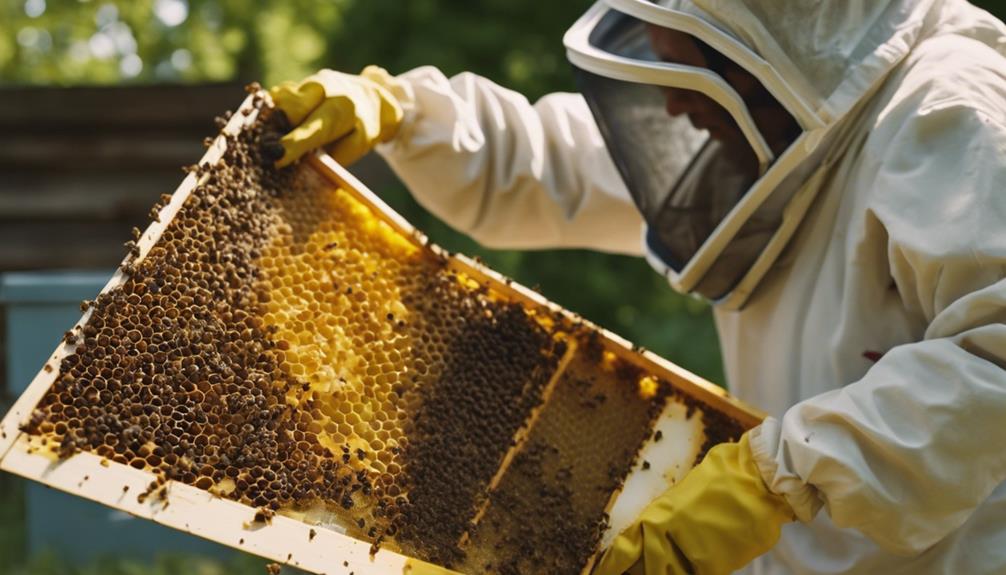When contemplating the best bee hive, there are various options to explore based on your preferences and needs. The Langstroth hive is popular for its modular design and ease of management, perfect for commercial beekeeping. On the other hand, the Top Bar hive offers a hands-off experience with its unique horizontal layout. If you prefer minimal intervention, the Warré hive might be ideal, focusing on natural methods and insulation. For those looking for convenience in honey extraction, the Flow Hive‘s key-turn extraction system is a standout feature.
Additionally, the Apimaye hive stands out for its superior ventilation and pest protection. Each hive has its own advantages depending on your beekeeping style and goals.
Main Points
- Langstroth Hive: Ideal for efficient management and commercial beekeeping.
- Top Bar Hive: Promotes natural comb construction and hands-off beekeeping.
- Warré Hive: Emphasizes sustainability but may yield less honey.
- Flow Hive: Easy honey extraction with minimal disruption to bees.
- Apimaye Hive: Offers superior ventilation, mite protection, and durability.
Langstroth Hive Overview
Langstroth hives transform beekeeping with their modular design and efficient management features. These hives boast removable frames, allowing for easy inspection and manipulation during bee management.
The standardized size and shape of Langstroth frames make them ideal for commercial beekeeping, where uniformity streamlines operations. Honey extraction becomes a breeze with the convenient frame system, simplifying the process of harvesting the sweet nectar produced by the bees.
Additionally, the efficient design of Langstroth hives promotes ideal bee management practices, ensuring that beekeepers can easily monitor and care for their colonies. Whether you’re a seasoned beekeeper or just starting out, the practicality and effectiveness of Langstroth hives make them a popular choice for those seeking to maximize their beekeeping efforts.
Top Bar Hive Features
Top Bar hives not only offer a unique horizontal design but also promote easier inspections due to their accessible layout.
With the wooden bars allowing bees to construct comb naturally, these hives provide a less disruptive environment for the bees.
Embracing a minimal disturbance approach, Top Bar hives are favored by many beekeepers seeking a more hands-off and natural beekeeping experience.
Design for Easy Inspection
Utilizing a horizontal design with wooden bars instead of frames, the Top Bar hive features a structure that encourages bees to construct comb downward from the top bars.
- Frequent inspections are necessary in Top Bar hives to prevent overcrowding and swarming, as the lack of structured frames requires more hands-on monitoring.
- The absence of foundation in these hives allows bees to create natural comb structures, promoting a more organic environment for the bees.
- Easy hive inspections are facilitated by the simple design of Top Bar hives; just lift out a single bar for a quick and straightforward check-up.
Top Bar hives offer beekeepers a cost-effective and low-maintenance option, ideal for those seeking a more hands-on and freedom-filled beekeeping experience.
Natural Comb Building
Encouraging natural comb building, the design of Top Bar hives promotes a habitat that aligns with bees’ instinctual comb construction. Unlike traditional hives with foundation sheets, Top Bar hives allow bees to create comb downward from wooden bars, mimicking their wild comb structure. This setup respects bee instincts, letting them decide on comb spacing without predetermined frame spaces.
However, this freedom requires more frequent hive inspections to prevent overcrowding and swarming. By embracing the bees’ natural tendencies, Top Bar hives provide a space where bees can thrive according to their own needs. So, if you value the freedom of bees to build their comb as they see fit, a Top Bar hive might just be the perfect choice for you.
Minimal Disturbance Approach
Embracing a natural approach to beekeeping, the design of Top Bar hives prioritizes minimal disturbance by allowing bees to construct their own comb without the constraints of frames.
- Hive inspections are a breeze in Top Bar hives; simply lift out a single bar for observation.
- Bees in Top Bar hives exhibit natural behavior as they create comb without the need for foundation.
- Top Bar hives cater to beekeepers seeking a simpler hive design that aligns with the bees’ natural tendencies.
Choosing a Top Bar hive means giving your bees the freedom to thrive in an environment that respects their instincts. With minimal interference, these hives offer a more hands-off approach, letting the bees do what they do best – build their home the way nature intended.
Warré Hive Pros and Cons
Warré hives offer a sustainable approach to beekeeping with their emphasis on natural methods. These hives provide excellent insulation for bees, protecting them in varying weather conditions.
However, they require regular inspections for mite control and may yield less honey compared to other hive types.
Warré Hive Benefits
Mimicking bees’ natural nesting habits, Warré hives offer unique benefits for beekeepers seeking sustainable and low-intervention beekeeping practices. These hives provide excellent insulation for bees, keeping them cozy during extreme weather conditions. Additionally, Warré hives promote natural beekeeping methods, aligning with the desire for a hands-off approach to hive management. They’re perfect for those looking to practice sustainable beekeeping while minimizing their intervention in the bees’ natural processes.
The low-intervention aspect of Warré hives allows beekeepers the freedom to observe bees more naturally without constant interference. It’s important to note that regular inspections are necessary to guarantee bee health and address any issues promptly.
- Emphasizes natural beekeeping methods
- Provides insulation for bees
- Supports sustainable and low-intervention practices
Warré Hive Drawbacks
While Warré hives offer benefits for sustainable and low-intervention beekeeping, they also come with certain drawbacks that beekeepers need to contemplate. Warre hives don’t effectively control Varroa mites, necessitating regular inspections for pest management. Additionally, due to their design, these hives tend to produce less honey than other hive types such as Langstroth. Ensuring colony health in a Warre hive requires consistent and thorough monitoring through regular inspections.
Besides, the top-heavy design of Warre hives can pose stability issues, potentially needing extra support to prevent accidents. Despite these challenges, many beekeepers appreciate the simplicity and natural beekeeping practices that Warre hives promote, highlighting the importance of finding a balance between intervention and autonomy in beekeeping practices.
Flow Hive Benefits

Utilizing a patented flow mechanism, Flow Hives offer beekeepers a convenient and bee-friendly method for extracting honey without disturbing the bees. Here are some key benefits of using Flow Hives:
- Easy Honey Extraction: With a simple turn of a key, beekeepers can harvest honey effortlessly, eliminating the need for traditional and often labor-intensive extraction equipment.
- Less Labor-Intensive: The innovative Flow Hive system streamlines the harvesting process, reducing the physical effort required and making beekeeping more accessible to enthusiasts of all levels.
- Bee-Friendly: By minimizing disruptions during honey extraction, Flow Hives prioritize the well-being of the bees, promoting a healthier and happier colony overall.
Flow Hives are a popular choice for those seeking a more efficient and bee-conscious approach to honey harvesting.
Apimaye Hive Advantages
Apimaye hives provide superior ventilation compared to traditional wooden hives, essential for maintaining a healthy hive environment.
The inclusion of a varroa mite excluder screen in Apimaye hives acts as a shield against these harmful pests, safeguarding the bees’ well-being.
Their durable plastic construction not only guarantees longevity but also prevents warping that can compromise hive integrity.
Cleaning Apimaye hives is a breeze, reducing the risk of diseases and pest infestations.
While they may require a higher initial investment, the long-term benefits in terms of hive health make Apimaye hives a wise choice for beekeepers looking to prioritize the well-being of their buzzing companions.
Hive Comparison Chart

When evaluating bee hives, it’s crucial to ponder factors like the materials used and design features present. These elements can significantly influence the hive’s functionality and the ease of beekeeping activities.
Hive Material Comparison
Comparing different hive materials is important to determining the best option for beekeepers based on their specific needs and preferences. When considering hive material, factors like durability, maintenance, and bee acceptance play a vital role in decision-making.
Here are some key points to keep in mind:
- Wood Hives: Natural and recyclable with a lovely honey scent, but prone to warping and require more effort to clean.
- Plastic Hives: Durable, easy to maintain, and pest-resistant, yet pricey and not easily recyclable, potentially impacting bee acceptance.
- Apimaye Hives: Offer improved ventilation and mite control, though they come at a higher initial cost.
Hive Design Features
Among the various hive design features available to beekeepers, Langstroth hives stand out for their convenient removable frames that facilitate easy inspection and honey extraction. These hives offer beekeepers the flexibility to manage colonies efficiently, ensuring ideal hive health.
On the other hand, Top Bar hives mimic natural comb structures but require more frequent inspections. Warre hives focus on natural beekeeping methods with minimal intervention, while Flow hives simplify honey extraction through innovative design. Apimaye hives, with insulated walls and varroa mite exclusion features, provide durability and protection.
Understanding bee space and hive design is vital for successful beekeeping, as it impacts colony productivity and health. Each hive design has its unique features, catering to different beekeeper preferences and management styles.
Hive Maintenance Tips
To maintain peak hive health and longevity, regular inspections are essential to prevent wood rot and address any necessary repairs promptly. When it pertains to hive maintenance, a few key tips can make a significant difference in the overall well-being of your bee colony:
- Moisture Control: Keeping moisture levels in check is important for preventing wood rot and ensuring the durability of your wooden beehives.
- Timely Repairs: Identifying and fixing any issues during inspections promptly can help extend the lifespan of your hive.
- Adjusting Frames: Adapting frames and boxes based on seasonal changes and colony needs is crucial for effective hive management.
Bee Health Considerations

Inspecting the hive regularly allows us to monitor bee health indicators like brood patterns, population size, and pests, ensuring the well-being of the colony.
Proper hive ventilation is essential to prevent moisture buildup and fungal issues, promoting healthier bees.
Adequate space within the hive prevents overcrowding and stress, maintaining a harmonious environment.
Keeping the hive clean is pivotal to ward off diseases and parasites that can harm bee health.
Monitoring honey stores and pollen availability guarantees that bees have ample food for sustenance and growth.
Hive Inspection Guidelines
Regular hive inspections play an important role in monitoring bee health and colony development during peak seasons. When conducting hive inspections, it’s vital to focus on various aspects to guarantee the hive thrives.
Here are three key guidelines to keep in mind:
- Check for signs of disease, pests, and queen performance to address any issues promptly.
- Look for proper brood patterns, sufficient food stores, and overall hive population growth for a healthy colony.
- Make sure the hive has adequate ventilation, space, and proper comb construction to support the bees’ needs.
Choosing the Right Beehive

When selecting the most suitable beehive for your beekeeping operation, considering factors such as cost, maintenance requirements, and your beekeeping goals is vital. Different hive types like Langstroth, Warre, and Top Bar hives each offer unique advantages suited to various beekeeping practices.
The design of the hive can influence bee behavior and productivity significantly. Understanding the characteristics and benefits of each hive type is essential for making an informed decision. By researching and comparing these options, you can find the best fit based on your preferences and beekeeping needs.

Hello! My name is Noel Calvin. I graduated from UCLA and now work as a writer at Launch Ninjas. I write blog posts that inspire and guide our readers in their entrepreneurial pursuits. I live in Pleasantville, NJ, with a peaceful yet lively atmosphere that inspires me.
Writing stories is more than just a job for me. It allows me to share my observations and satisfy my curiosity about the world. I combine my analytical skills with creative enthusiasm to delve into technology trends and startup stories. But my life isn’t limited to screens and keyboards. I value loyalty, passion, and a touch of old-fashioned charm, which I infuse into every narrative I create.
I love spending time in my garage, jamming with my band when I’m not writing. Playing the guitar and singing bring me immense joy. I also enjoy capturing ordinary and extraordinary moments through my camera lens and exploring new culinary adventures that excite my taste buds. I’m always seeking new experiences.
My family is very important to me. Joyful Sunday brunches filled with laughter and intense board game nights keep me grounded, reminding me of life’s simple pleasures.
In my world, every moment is an opportunity for discovery. Every discovery is a story worth sharing, whether a heartfelt moment at home or the pulse of technological innovations. Join me as I navigate through life, one blog post, one guitar strum, and one heartwarming family dinner at a time.


